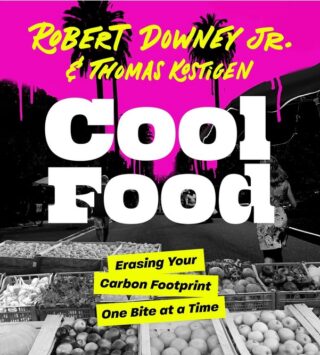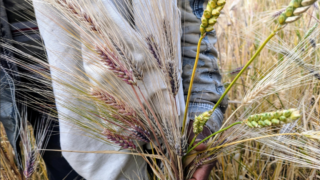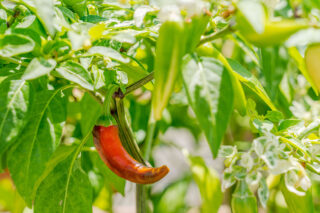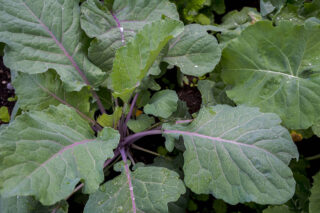Cool Food: Eat Your Way to a Healthier Environment
Cool Food: Erasing Your Carbon Footprint One Bite at a Time, a new book by actor Robert Downey Jr. and bestselling author Thomas Kostigen, includes a thought-provoking interview with NYBG’s Alex McAlvay, Ph.D.
At NYBG, Dr. McAlvay works as Assistant Curator at the Institute of Economic Botany, and his expertise in ethnobotany, or the study of the relationship between people and plants, was an important piece in the book’s mission to give readers practical and applicable ways to help the climate through our consumption habits.

The book’s fun title brings up important words in the environmental sphere.
Greenhouse gases (GHGs) are gases in Earth’s atmosphere that trap heat, including carbon dioxide. A carbon footprint is the total amount of greenhouse gases that are generated by our actions, either individually or collectively, which in turn contributes to climate change. We generate GHGs in many ways: emissions from our cars, the energy we use in our homes, and, as this book shows, the food we eat.
So, “Cool Food”—cooling the climate, and “Erasing Your Carbon Footprint”—making sure our decisions are mindful. But how does “One Bite at a Time” fit into all of this? How can food contribute to the amount of greenhouse gases in our atmosphere and therefore climate change?
Unfortunately, it can do so at every step of the way—from the time it’s grown and harvested to the time it reaches our plates. As the World Wildlife Fund puts it, “Food needs to be grown and processed, transported, distributed, prepared, consumed, and sometimes disposed of.” On top of that, food waste that goes into a landfill will rot and produce methane—a highly potent GHG.
In 2021, the agricultural sector, which includes crops and livestock, made up 10% of global emissions, according to U.S. Environmental Protection Agency—having increased by 7% since 1990. Globally, agriculture is also the largest contributor to methane emissions, according to Our World In Data. Most of this methane comes from livestock, which produces it through digestive processes.

It’s a daunting thought, but before you go rummaging around in your fridge—don’t freak out! A lot of these emissions are due to factors beyond our control—and it’s up to our food systems as a whole to move toward more sustainable methods.
However, you can still help the cause, and that’s what Cool Food seeks to prove. There is still hope in many forms, and this one is—well, food.
In our previous blog post about Dr. McAlvay, we touched on his work with communities around the world to revitalize traditions of sustainable agriculture and management of wild resources. Essentially, he seeks to understand Indigenous ways of growing food—methods that have been used for hundreds of years and are still working. Even in the wake of a changing climate, these crops have survived increased temperature, pests, drought, floods, and other natural disasters.
As the book puts it, he studies “how cultures around the world, for much of history, have figured out how to eat and not tank the planet.”

Dr. McAlvay’s work is important to address how we can apply sustainable farming practices to our agricultural systems—and especially how technology today can be adapted to work with, not against, ancient innovations.
“The idea is that people have developed locally adapted food systems over thousands and thousands of years,” he says in Cool Foods, “and they’ve undergone climate change, they’ve undergone extreme weather events, and they’ve persisted, or we wouldn’t be here today.”
In the U.S., we’re struggling with growing monocrops, but in places like Ethiopia, the Republic of Georgia, and elsewhere, farmers are growing native species that naturally occur together—here, these are often seen as weeds, disrupting the uniform rows and rows of modern agriculture.
Dr. McAlvay is all about applicable solutions, and he gives quite a few in the book:
- Foraging, in wild or urban spaces
- Many foods typically seen as weeds are edible—and tasty, too! Before you embark on your foraging journey, make sure you do your research so you know which plants are safe to eat.
- Urban landscaping with native and edible plants
- Green spaces in urban environments can be used for good, not only recreationally, but also as habitats and food sources for pollinators and for foraging.
- Planting your own garden
- Want to be ultra eco-friendly? If you have the space, learning to grow your own food is one way to do it. By planting, harvesting, and composting—and using sustainable irrigation methods—you can create a system that saves water, limits emissions, is low-waste, and gives you fresh produce!
- Encouraging Indigenous, entrepreneurial endeavors that maintain regenerative methods and low carbon ecosystems
- Dr. McAlvay noted that many Native American tribes in the U.S. have projects where you can buy the food these tribes produce, such as wild rice, hickory nuts, and chili peppers.
- Innovative mash-up of traditional systems
- In our previous blog post, Dr. McAlvay spoke about his studies on maslins, which are multiple varieties of grains grown in the same field, such as wheat and barley. These are naturally-occurring—farmers just took the hint from Mother Nature and kept growing them together—and growing multiple varieties provides a buffer during droughts and other severe conditions. Another example that Dr. McAlvay mentions in Cool Food is the Three Sisters, an Indigenous system with corn, beans, and squash. By combining traditional, Indigenous methods with other technology, we’ll develop more sustainable, ethical, and efficient agricultural practices.
At the end of the chapter, Dr. McAlvay makes sure to highlight what this is all about: protecting people and protecting plants. The climate, and the carbon cycle, connect us all.

“In terms of carbon,” says Dr. McAlvay, “you can put your money towards those things that help the continuation of people.”
As Cool Food notes, the thing he encourages most is “to look at food as a connection to other people, places, and things all around the world.”
Cool Food: Erasing Your Carbon Footprint One Bite at a Time is available at NYBG Shop.
SUBSCRIBE
Enter your email address to subscribe to this blog and receive updates on new posts.











